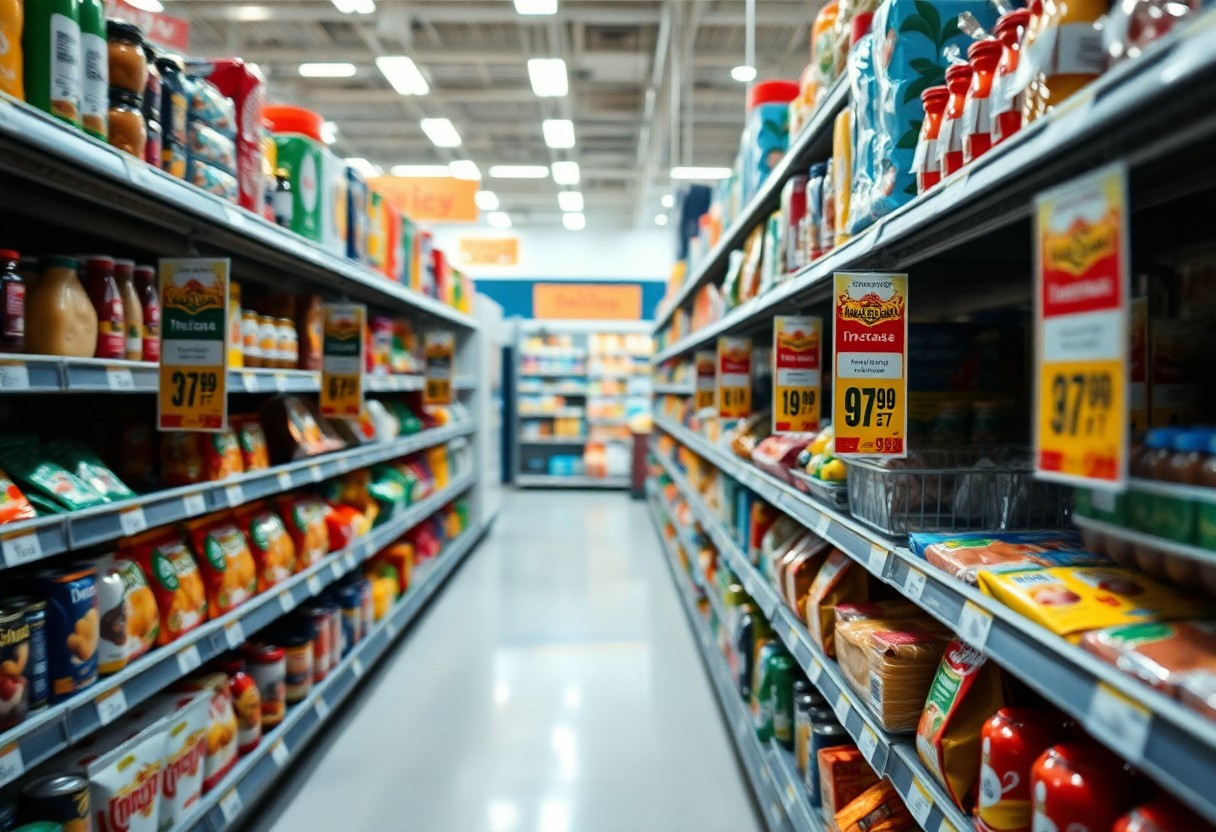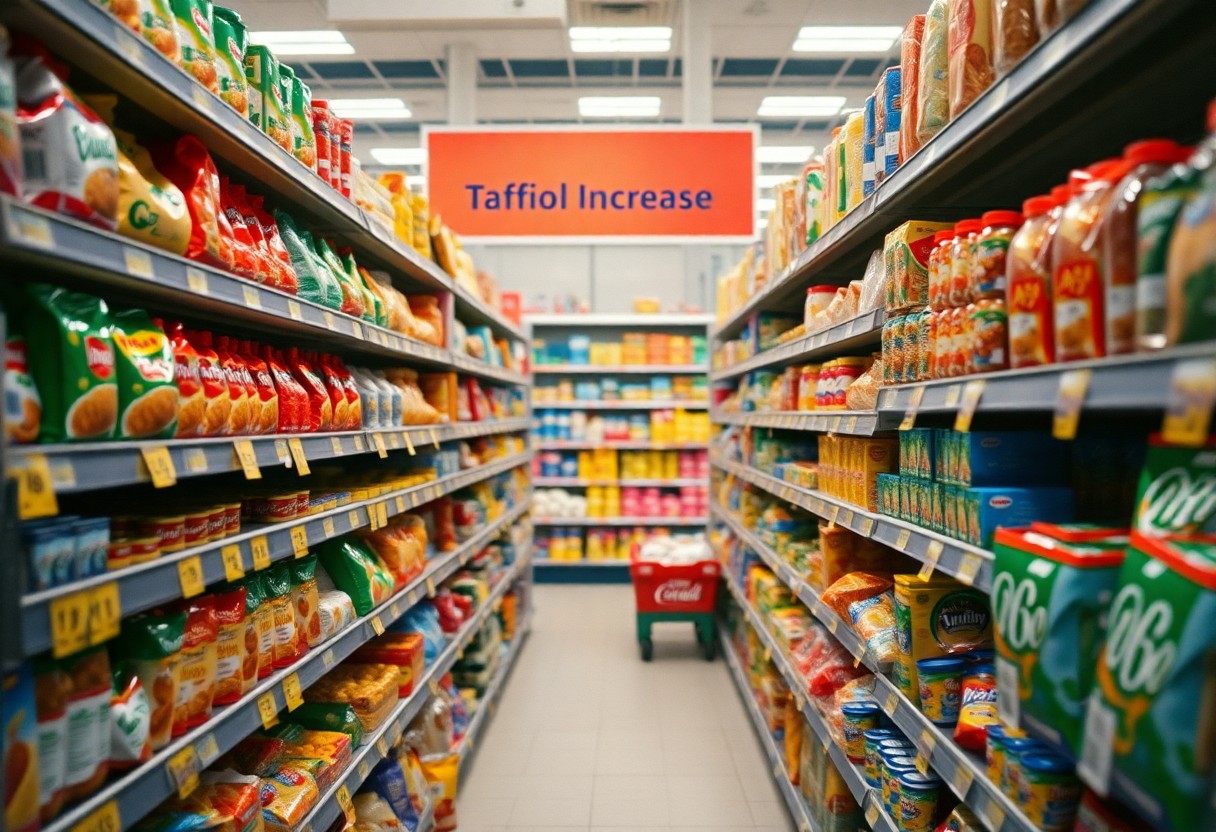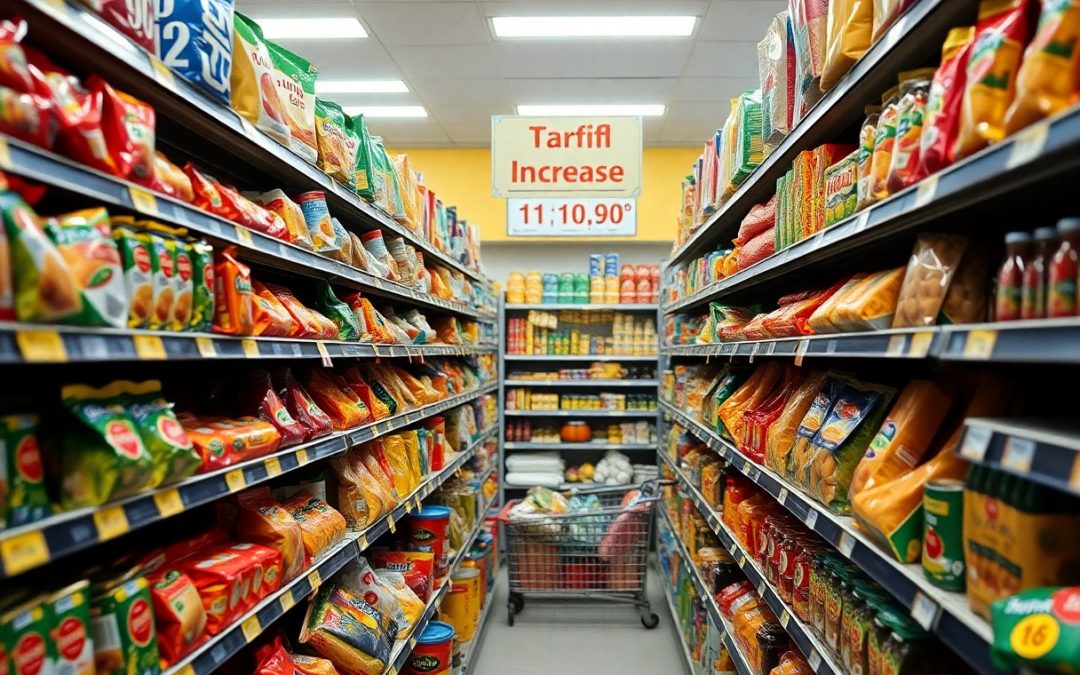Food prices in your grocery store are expected to rise due to newly imposed tariffs that add 10 percent on most imports and 125 percent on Chinese goods. As a result, items like coffee, chocolate, and olive oil may become more expensive. This comes at a time when you’re already facing higher costs due to inflation, putting further strain on your budget. Additionally, the health implications of consuming more costly options should not be overlooked, as these changes may affect your choices and overall well-being.
Overview of Tariffs and Their Impact
The recent implementation of tariffs on imported goods will have significant implications for food prices in the United States. These tariffs function as taxes on products coming from abroad, which are likely to lead to higher grocery costs. With crucial items already seeing a price increase of over 20% since the pandemic, the additional financial burden from tariffs could further stretch your budget.
Definition of Tariffs
Impact wise, tariffs are government-imposed taxes on imported goods that raise their price for consumers, intended to protect domestic industries. These taxes can make foreign products less competitive in the local market, often leading to increased prices for everyday goods, including food.
Scope of Current Tariffs
Beside China, which faces a steep 125 percent tariff on imports, most other countries are subjected to a 10 percent tariff on various goods. This includes many products you rely on for your everyday meals.
With American reliance on imports for many food staples like olive oil, coffee, and chocolate, the 10 percent tariff will likely increase the prices you pay at the supermarket. Although the president has paused plans for higher tariffs, the economic impact is significant. As food prices continue to climb, those on a tight budget will feel the pinch the most, especially with higher costs affecting your favorite healthy options and staples alike.

Effects on Food Prices
There’s no doubt that the recent tariffs imposed by President Trump will significantly influence the cost of food in America. With a 10 percent tariff on many imported goods and a staggering 125 percent on products from China, you can expect to see a ripple effect on grocery prices. This comes at a time when prices have already surged over 20 percent since the COVID-19 pandemic, further straining your budget.
Overall Grocery Price Increase
By anticipating price increases across the board, you’re likely to feel the squeeze at the checkout line. The combination of tariffs and already rising costs will result in overall grocery bills climbing higher, making it vital to adjust your shopping habits.
Specific Food Categories Affected
Behind the general price hikes, certain food categories will be hit particularly hard. Staples such as olive oil, coffee, and chocolate are all expected to see significant increases as tariffs affect imports. Understanding which foods will be impacted can help you make smarter purchasing choices.
To research deeper into the specific food categories affected, you’ll find that items like avocados and berries, which rely heavily on imports, are set to experience cost increases due to the new tariffs. The U.S. imports the majority of its olive oil from the EU, meaning you should prepare for rising prices on this kitchen staple. Furthermore, the already high costs of superfoods, which are vital for your health, will likely escalate, making your grocery shopping decisions even more critical during these uncertain times.

Analysis of Major Food Items
Assuming the recently imposed tariffs remain in effect, you can expect significant price increases on a variety of crucial food items. The 10 percent tariff on imports will affect pantry staples like chocolate, olive oil, coffee, avocados, and nuts, which are often sourced from countries that will see increased costs due to these changes. As these expenses rise, you will likely notice the impact on your grocery bills, particularly for these healthy and high-demand products.
Impact on Chocolate Prices
Chocolate, particularly dark chocolate, is a favorite for many due to its nutritional benefits and ability to satisfy cravings. With tariffs now affecting imported chocolate, you may find that your beloved chocolate bars cost more at checkout.
Effects on Olive Oil Costs
With most olive oil in the U.S. imported from the European Union, the newly imposed tariffs will lead to higher prices for this staple. As a result of the 10 percent tariff rate, the cost of olive oil may rise significantly, impacting your cooking expenses.
At the same time, olive oil is a key component of a balanced Mediterranean diet, renowned for its heart-healthy fats. Therefore, as prices for imported olive oil climb, you might be forced to consider whether to scale back on your usage or seek alternative cooking oils, potentially jeopardizing your nutritional regime.
Price Changes for Coffee
With coffee being a daily ritual for many, the new tariffs are likely to make your regular cup at the café more expensive. Imported coffee beans will see a hike, aligning with the 10 percent tariff, which means your coffee budget may require adjustment.
Understanding these cost implications, you may need to rethink your coffee purchases. The struggle to find affordable substitutes becomes evident, especially since coffee is often a non-negotiable item in many diets. As prices rise, individuals whose food budgets are already tight will feel the strain even more acutely.
Rise in Cost of Avocados
On your grocery list, avocados are already among the pricier items, and tariffs may push their costs even higher due to reliance on imports. This increase means your current avocado purchases could become less sustainable on a tight budget.
Price fluctuations in avocados should also not be underestimated, as they provide crucial nutrients and healthy fats. As prices rise, you might find yourself reconsidering your purchase frequency or looking for alternatives to keep your meals nutritious without breaking the bank.
Nuts Pricing Implications
After the implementation of tariffs, pricing for nuts—an crucial healthy snack—may also be impacted. The increased costs could affect items such as almonds and cashews, which are often sourced from overseas producers.
Also, with nuts being a popular choice for snacking due to their health benefits, the potential for price increases could force you to reevaluate your options. Whether it’s choosing different varieties or buying in bulk, you will need to navigate these changes wisely to maintain your healthy snacking habits while managing costs.
Economic Considerations
Unlike other economic policies, tariffs directly impact the prices of goods you buy daily. As President Trump’s recent tariff announcement plays out, expect to see food costs rise, particularly for imported items. With grocery prices already increasing over 20% since the COVID-19 pandemic, any additional financial burden will compound your expenses and may lead to significant changes in your household budget.
Tariffs and Consumer Behavior
Among your potential responses to rising food prices may be a shift in buying habits. With crucial pantry staples becoming more expensive, you might prioritize purchasing local or less expensive alternatives to manage your grocery bills effectively. Some consumers may also start exploring alternative sources of nutrition, considering value and health benefits more than ever.
Effects on Food Insecurity
Beside the general price increases, those facing food insecurity will feel the brunt of these tariff-induced costs. As food prices rise, families already struggling to afford basic groceries will find it even harder to maintain a nutritious diet.
Insecurity around food access is exacerbated when tariffs lead to increased grocery costs. Low-income individuals and families, who often spend a larger portion of their income on food, could face a higher risk of malnutrition. Increased expenses on staples may force you to compromise on quality and quantity, affecting not only your physical health but also overall well-being. The potential rise in food prices could lead to more reliance on cheap, unhealthy foods, widening the gap in nutritional disparities.
Strategies for Consumers
Not all hope is lost in the face of rising food prices; there are several strategies you can adopt to manage your grocery bill effectively. Staying informed about price trends and shopping accordingly can help you minimize the impact of tariffs. Consider exploring local options, buying in bulk, or planning meals based on seasonal products to optimize your budget.
Smart Shopping Tips
Among the best methods for managing your grocery expenses are these smart shopping tips:
- Keep an eye on seasonal sales.
- Utilize coupons and online deals.
- Buy store brands instead of name brands.
- Consider bulk purchases for non-perishables.
Knowing these tactics can help safeguard your budget against the impending price increases due to tariffs.
Reducing Food Waste
One of the most effective ways to combat rising prices is by reducing food waste. By planning meals and utilizing leftovers, you significantly enhance the value you get from your grocery spending.
It’s important to adopt practices that cut down on waste, such as storing food properly, understanding expiration dates, and using ingredients creatively. According to Dr. Ortega, the average American wastes between 30-40% of their food supply, which indirectly contributes to rising prices, as the costs of waste trickle down to consumers. Educating yourself on how to maximize the lifespan of your food not only helps in tackling your budget but also promotes health through better consumption habits. By making meaningful changes, you can maintain your health while saving more in your daily expenses.
Future Outlook
For many Americans, the reality of rising food prices due to tariffs may feel overwhelming. As tariffs on crucial food items and ingredients are expected to impact your grocery bill, it’s vital to stay informed about possible strategies to mitigate these increases and navigate the changing landscape of food costs. The implications of these tariffs could last for years, affecting your budget and day-to-day choices.
Potential Changes in Tariff Policy
Future adjustments to tariff policies could either exacerbate or alleviate the financial burden on consumers. Depending on political negotiations and economic conditions, existing tariffs may be adjusted, reopening the possibility for lowered costs on crucial imports or leading to further hikes that financially strain your grocery shopping experience.
Long-term Effects on Food Supply
Before adjusting to new price structures, consider the long-term effects tariffs may have on your food supply. These tariffs can disrupt established supply chains, resulting in decreased availability of certain food products. As reliance on imported goods remains high, consistent price fluctuations could leave you scrambling for alternatives, thus diminishing your overall food choices.
Even with strategies to adapt, the reality remains that you may face an uncertain food supply as tariffs persist. Increased prices on imports can lead to less variety and higher costs for staples, while food insecurity could rise for many families already struggling with affordability. With grocery prices up over 20% since the COVID-19 pandemic, the ongoing tariff issue may further challenge your ability to maintain a balanced and nutritious diet, particularly as you seek healthier options.
Summing Up
So, as the new tariffs take effect, you can expect a significant increase in food prices across the board, affecting your grocery bill more than before. Essential items such as chocolate, coffee, and olive oil will likely see price hikes, making it harder to maintain your usual shopping habits. With already rising costs, especially for nutritious foods that support your health, it’s important to stay informed and budget accordingly to manage the impact on your finances.
FAQ
Q: How do tariffs specifically impact the prices of everyday food items for Americans?
A: Tariffs impose additional costs on imported goods, which are then typically passed on to consumers. For example, the recent 10 percent tariff on many countries, and a significantly higher tariff on Chinese goods, means that the costs of importing staple items such as chocolate, coffee, and olive oil will rise. This will likely lead to an increase in grocery bills as store owners adjust their prices to cover the additional expenses linked to these tariffs.
Q: Are there particular food categories that will be affected more than others due to these tariffs?
A: Yes, the tariffs will likely impact a range of products, but items that are not produced domestically or are seasonal will see a more pronounced price hike. This includes pantry staples like olive oil, coffee, and superfoods such as berries and nuts. Since many of these items are imported from countries that fall under the tariff rules, consumers can expect to pay more at the checkout.
Q: What can consumers do to mitigate the rising costs of food due to these tariffs?
A: Consumers can take several steps to manage their grocery bills in light of rising prices. Shopping seasonally, buying in bulk, and being flexible with brand choices or substitutes can help reduce costs. Additionally, being mindful of waste and planning meals carefully can lead to more economical eating habits. It’s crucial to prioritize a balanced diet while considering overall budgeting, especially as these changes might impact access to nutritious food options and overall health.


